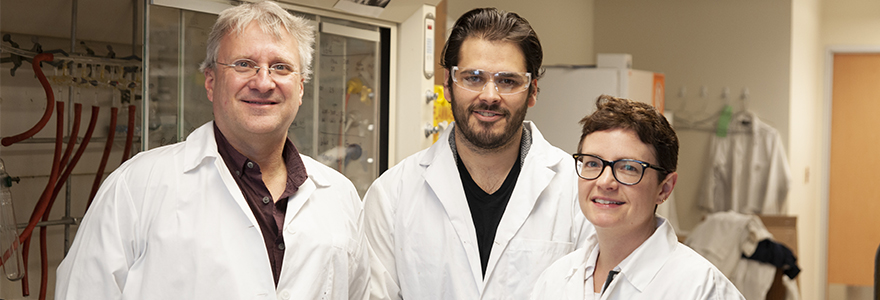A targeted osteoarthritis treatment

With one in six Canadians suffering from osteoarthritis and the current leading therapies targeting only joint pain and swelling, an unlikely duo of scientists is combining their individual skill sets to crack the puzzle of how to treat the condition. Beth Gillies from the Department of Chemistry and Frank Beier, a musculoskeletal researcher from Western University have joined forces to develop a novel therapy to slow and prevent the breaking down of cartilage in joints. “Right now, the best we can do is treat symptoms, not do anything about the actual disease progression,” says Beier, who has dedicated a substantial portion of his career to understanding the molecular pathways that break down our joints. Any pharmaceutical solution to osteoarthritis likely has too many adverse side effects to be useful when administered as a pill or injection into the bloodstream. Enter Beth Gillies, the polymer chemist.
“Instead of administering the medicine traditionally, we’re using innovative chemical compounds that release the drug steadily over a three-month period,” explains Gillies. The slow-release polymer containing the medicine can be injected directly into the joint, preventing side effects from occurring elsewhere in the body. The main challenge from a materials science perspective is to create a polymer that can release the drug slowly enough that it need only be injected every three months – the recommended minimum clinical interval for current joint injections – while withstanding mechanical forces within the joint.
Also taking a swing at this knuckleball is PhD student Ian Villamagna, co-supervised by Gillies and Beier. “It’s certainly a non-traditional collaboration,” laughs Villamagna – his supervisors have come together as a result of the Centre for Advanced Materials and Biomaterials Research (CAMBR). “The Centre is a real paradise for students like me; it breaks down traditional silos and creates opportunities for unorthodox collaborations,” says Villamagna. His interdisciplinary background in chemistry and physiology made him the perfect fit for a project spanning Faculties. “The challenge when working in completely unrelated labs is to keep a clear understanding across the board,” he explains, “so I act as that bridge.”
CAMBR brings together scientists across campus to foster multidisciplinearity in materials research, focussing on key applications including energy, environment, and health. This project, supported by Western’s Bone and Joint Institute, is one of many at CAMBR seeking to solve problems by mobilizing research groups that would otherwise not come into contact with one another. “To be working on a real problem is very motivating,” points out Gillies, “and working with people outside of my own department encourages us to devise creative solutions that could never be developed individually.” As CAMBR’s roster of collaborators continues to grow, so too does the number of imaginative teams that are dedicating themselves to engineering advanced materials for everyday issues like osteoarthritis.

